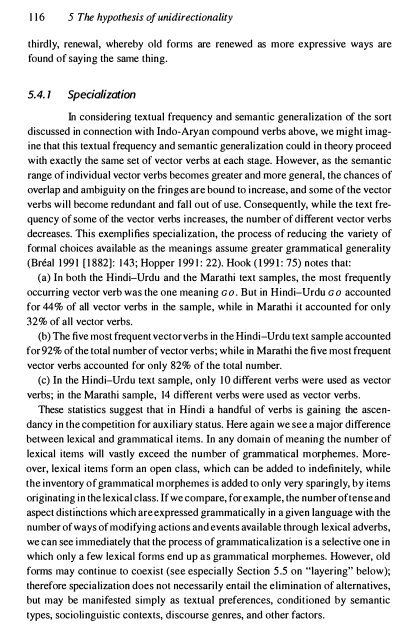Gram - SEAS
Gram - SEAS
Gram - SEAS
Create successful ePaper yourself
Turn your PDF publications into a flip-book with our unique Google optimized e-Paper software.
116 5 The hypothesis of unidirectionality<br />
thirdly, renewal, whereby old forms are renewed as more expressive ways are<br />
found of saying the same thing.<br />
5.4. 1 Sp ecialization<br />
In considering textual frequency and semantic generalization of the sort<br />
discussed in connection with Indo-Aryan compound verbs above, we might imagine<br />
that this textual frequency and semantic generalization could in theory proceed<br />
with exactly the same set of vector verbs at each stage. However, as the semantic<br />
range of individual vector verbs becomes greater and more general, the chances of<br />
overlap and ambiguity on the fringes are bound to increase, and some of the vector<br />
verbs will become redundant and fall out of use. Consequently, while the text frequency<br />
of some of the vector verbs increases, the number of different vector verbs<br />
decreases. This exemplifies specialization, the process of reducing the variety of<br />
formal choices available as the meanings assume greater grammatical generality<br />
(Breal 1991 [1882]: 143; Hopper 1991: 22). Hook (1991: 75) notes that:<br />
(a) In both the Hindi-Urdu and the Marathi text samples, the most frequently<br />
occurring vector verb was the one meaning GO. But in Hindi-Urdu GO accounted<br />
for 44% of all vector verbs in the sample, while in Marathi it accounted for only<br />
32% of all vector verbs.<br />
(b) The five most frequent vector verbs in the Hindi-Urdu text sample accounted<br />
for 92% of the total number of vector verbs; while in Marathi the five most frequent<br />
vector verbs accounted for only 82% of the total number.<br />
(c) In the Hindi-Urdu text sample, only 10 different verbs were used as vector<br />
verbs; in the Marathi sample, 14 different verbs were used as vector verbs.<br />
These statistics suggest that in Hindi a handful of verbs is gaining the ascendancy<br />
in the competition for auxiliary status. Here again we see a major difference<br />
between lexical and grammatical items. In any domain of meaning the number of<br />
lexical items will vastly exceed the number of grammatical morphemes. Moreover,<br />
lexical items form an open class, which can be added to indefinitely, while<br />
the inventory of grammatical morphemes is added to only very sparingly, by items<br />
originating in the lexical class. If we compare, for example, the number of tense and<br />
aspect distinctions which are expressed grammatically in a given language with the<br />
number of ways of modifying actions and events available through lexical adverbs,<br />
we can see immediately that the process of grammaticalization is a selective one in<br />
which only a few lexical forms end up as grammatical morphemes. However, old<br />
forms may continue to coexist (see especially Section 5.5 on "layering" below);<br />
therefore specialization does not necessarily entail the elimination of alternatives,<br />
but may be manifested simply as textual preferences, conditioned by semantic<br />
types, sociolinguistic contexts, discourse genres, and other factors.
















